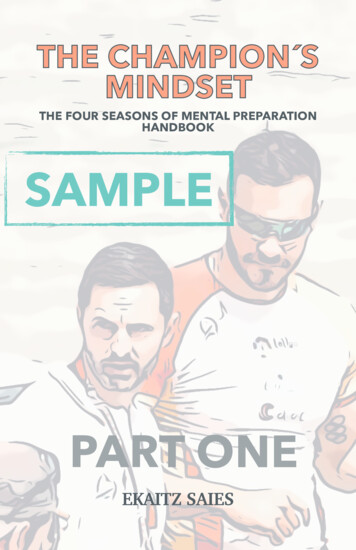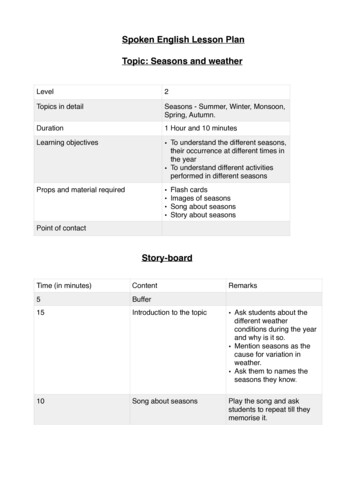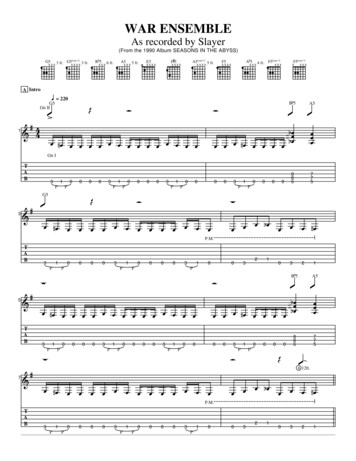
Transcription
THE CHAMPION SMINDSETTHE FOUR SEASONS OF MENTAL PREPARATIONHANDBOOKSAMPLEPART ONEEKAITZ SAIES
ABOUT THE AUTHORI am a high performance director and consultant based in San Sebastian(Basque Country, Northern Spain) where I live with my wife and threechildren.I was an international kayaker for over 15 years and during that time Iwon two World titles with my teammates.I got a Ph.D. in Psychology of Education specializing in sport performancepsychology. I periodically work at the University of the Basque Country(UPV/EHU) as a lecturer.I also worked as a Performance Director at the Royal Spanish CanoeFederation. I was the Team Leader at the Rio 2016 Olympic Games, wherethe Spanish Canoeing team won four medals (three gold and a bronze).At the same time, I help people who want to reach and maintain theirpotential in different areas related to performance.I apply evidence-based procedures and experience based practices to helppeople to achieve optimal wellbeing while delivering their bestperformance. Ekaitz Saies 20212
THECHAMPION SMINDSETTHE FOUR SEASONS OFMENTAL PREPARATIONHANDBOOKPART ONEEKAITZ SAIES3
CONTENTSPART ONEINTRODUCTIONWINTERMOTIVATIONA LITTLE PERSONAL STORYGOAL SETTINGSELF-AWARENESSDEALING WITH DIFFICULTIESTOLERANCE TO FATIGUE AND PAIN (GROUNDWORK)IMAGERY (VISUALIZATION OF SPECIFIC SPORT TECHNIQUE)MINDFULNESS (BASIC)AUTOGENIC TRAININGEND OF PART ONESPRINGSELF-EFFICACYEMOTIONAL MANAGEMENT (GROUNDWORK)ACTIVATION TECHNIQUESIMAGERY (PRE-COMPETITION)MINDFULNESS (MOVEMENT)DEALING WITH DIFFICULTIESTOLERANCE TO FATIGUE AND PAIN (INTENSITY)EMOTIONAL RESTORATIONSUMMEREMOTIONAL MANAGEMENT (COMPETITION)COMPETITION RUTINESCOMPETITION PLANOPTIMAL ACTIVATIONRELAXATION TECHNIQUES (COMPETITION)IMAGERY (TACTICS)MINDFULNESS (SPECIFIC)FLEXIBILITY AND TOLERANCE TO CHANGECONFIDENCE AND POSITIVE SELF-TALKHALO EFFECTAUTUMNEVALUATIONEMOTIONAL RESTORATIONCREATIVITY4
“We must undergo a hard winter training and not rush into things for whichwe haven’t prepared.” - Epictetus”Make it as simple as possible, but not simpler.” - Albert Einstein"Not having heard something is not as good as having heard it; having heardit is not as good as having seen it; having seen it is not as good as knowingit; knowing it is not as good as putting it into practice.” - Xun5
PROLOGUEIt makes me so happy to see you here! It means that you are curiousabout learning how you can perform better by working on your mentalskills.This handbook is aimed at athletes who aspire to improve theirperformance and see their potential flourish.When I was about to finish my sporting career, I decided to thoroughlyinvestigate the questions I asked myself when I was an elite athlete:Why do some people perform better under pressure?Why, if everyone gets into a final with very similar marks, some performmuch better than others?How can some players control their emotions when a penalty shot is sodecisive? And many more.This handbook will lay the foundations for learning how to perform yourbest when it really matters.You will not just learn what the top performers do to prepare themselvesand achieve success under pressure but you will put these techniques intopractice from the first to the last chapter.The journey through these four seasons has begun and it is an honor forme to be your traveling partner!6
INTRODUCTION7
INTRODUCTIONIn 1918 Max Plank received the Nobel Prize in Physics and spent severalmonths lecturing throughout Germany.They say that, wherever he went, he repeated the same speech and oneday his driver snapped at him:“Professor Plank, it must be boring to tell the same thing every day, evenif the scene and the audience changes. How about I go up on stage inMunich and you sit in the front row and put on my chauffeur cap?”The renowned scientist was amused by the proposal and accepted. Then,in Munich, his driver gave an extensive speech on quantum mechanicsbefore a distinguished audience in the Bavarian capital.When it was time for questions and answers, one of the attendingphysicists asked him the first question and the clever speaker replied: “Iwould never have imagined that in a city as sophisticated and advancedas Munich, someone could ask such a simple question.” He directed hisgaze towards the front row of the audience and continued:“My driver can answer this question.”Well, even being a very insightful person, it is clear that Dr. Plank's driver1had no practical or real knowledge of the matter, and often in life wemeet people capable of citing theories without actually having lived orexperienced them.Contrary to the usual trend, in my case, first came the experience andthen theory, therefore, my aim with this book is to share with you apractical and empirical method aimed to improve your performance byworking on your mental techniques and strategies. It will be a gamechanger.I present a four phase model, which I have called the four seasons, whichwould be winter, spring, summer and autumn.I’ve read that perhaps the story about Dr. Plank s chauffeur is not quite true or that it didn’t happen exactly in that way.However, the story is funny and works well for this context.18
The model can be adapted to your actual training periods. So it does notmatter if you do an individual sport or a team sport; a one peak sport or aleague sport. You just have to adjust the periods. The same goes forWinter sports. All you need to do is flip the seasons.Simply put: WINTER represents the pre-season or the high training volume phase. SPRING would be a more specific phase closer to competitions. SUMMER represents the competitive period. AUTUMN or FALL would be the transition and recovery phase.Traditionally, sports training has focused above all on physical training,often ignoring other fundamental aspects of performance such aspsychology, recovery or nutrition.Luckily today, there are many who also include within their preparationsthese three other fundamental corner stones for performance.However, in most cases, these do not usually work in an integrated andcoordinated manner with the other elements. For example, thepsychologist often does not know exactly in which training period theathlete is in, or the nutritionist is unaware of the caloric requirement of aspecific week, However,, if we want to achieve optimal performance,these four pillars must work in a synchronized manner.The problem with psychology is its complexity.This complexity is due to the incalculable variables that come into playand to the fact that we cannot accurately measure what is happening inour minds as we can do with lab tests, muscle biopsies, etc.So, as Einstein said, "Make it as simple as possible, but not simpler”.Therefore, the more variables and the more uncertainty, the simpler themodels should be. And for this reason, in the case of mental preparation,these models should be simple and effective. The important thing for us isjust to know what works, even if it is not perfect. Also, it is important toremark that this model that I am proposing should follow the principle of9
progression and be coherent with the training, nutrition and recovery ofeach period.You will only need two very simple and inexpensive things to put intopractice the techniques and strategies I propose in this handbook: a penand a diary.Every chapter will end with a specific exercise. The first chapters(motivation, goal setting, self-awareness and the development of ouridentity, dealing with difficulties and tolerance to fatigue and pain) willfocus on reflection. Whilst, the last three chapters (imagery, mindfulnessand autogenic training) will focus on practice.Many believe that mental work is like going to the physical therapist, “I liedown, I get a nice massage, and that's it”. But in reality, the best physicaltherapists I have worked with also make you work and give youhomework to do on your own.It is the same here. If you want to improvepsychologically, there are no shortcuts. You have to work, reflect, learn,change, master the basics, keep improving and keep working.10
WINTER11
WINTERThe philosopher Epictetus, who was born a slave, achieved his freedom andeven founded his own philosophical school almost 2000 years ago, said that:“We must undergo a hard winter training and not rush into things for which wehaven’t prepared.”Therefore, if we want to win, if we want to achieve our goals. prepara on isessen al.So how do we start preparing?We will start with a few psychological strategies and exercises that areimportant for laying the founda ons for what we would like to see later in themore exci ng seasons like Spring (pre-compe on period), where our e ortswill start ourishing, and especially Summer (compe on period), where wewill be able to see the fruit of our e orts.fftititititifftitiflti12
MOTIVATION13
MOTIVATIONTo be motivated means to be moved to do something. A person who feelsenergized or activated towards an end is considered motivated, whereassomeone who has no impetus or inspiration to act is unmotivated.Motives for sport participation differ and a distinction can be madebetween one’s intrinsic motivation (the pleasure of participating, seeingsome improvements, etc.) and extrinsic motivation (related to futurerewards, external recognition, punishments, etc.).Someone who is intrinsically motivated is inspired to participate in sportwithout being driven by an external incentive. Individuals feelindependence and competence when doing activities that are enforced byintrinsic motivation. When a person is intrinsically motivated he willparticipate for the mere pleasure of the activity.So on one side of the spectrum we find intrinsic motivation and on theother end is amotivation, an absolute lack of motivation.When I was a competitive athlete, I asked myself the following threequestions:Why do I do what I do?What do I want to achieve?What is my purpose?As an example, here are my answers when I was competing:Why do I do what I do?Because it reminds me of the fun I had with my father when we went onholidays with our kayaks. Also, because I remember what I felt when I tookpart in my first competition where I was second to last, and because of whatI felt the first time I won the Spanish championships.What do I want to achieve?I want to be the best I can be. My best version. And if that helps me wincompetitions, fantastic!14
(Well, depending on the day and on what was at stake I would’ve not beenas cool and I would’ve been more focused on results, but I did try to see itthat way most of the time)What is my purpose?Having fun doing what I love and doing what I am good at!Ok. Now I am going to answer the same questions but with my currentsituation. I still train almost every day and, even though I do not want tocompete anymore, I still love improving my performance.Here are my current answers to the same three questions:Why do I do what I do?Because I love being in contact with nature, because I love the feeling ofgliding over the water using just my own body as an engine, and because Ilove socializing with other paddlers who push me to go faster.What do I want to achieve?I just want to be as healthy as possible, both physically and mentally, andtry to slow down my own aging process.What is my purpose?I want to continue having fun doing what I love and also I want to inspirethose around me to stay healthy and have a good relationship with physicalactivity.15
�——————————————LET S ��Now it is your turn to answer those same three questions. You can writethe answers in your diary. Remember not to judge yourself independent ofthe outcome. There is no right or wrong answer. The goal here is tounderstand what motivates us. Why do I do what I do?What do I want to achieve?What is my purpose?16
A LITTLEPERSONALSTORY17
A LITTLE PERSONAL STORYTime for a personal story to give a bit of context for the next fewchapters:In December 2010 I suffered a terrible motorbike accident, just ninemonths before the 2011 World Championships and Olympic Qualifiers.The floor was wet and I pulled the brake a bit too quickly and I started tolose control of the motorbike. As I was falling down I put my right leg outto keep balance, but my foot also slipped and got trapped between thefloor and the motorbike. I heard several cracks from different parts of myback and neck. So I decided to lay still and hope that somebody wouldcall an ambulance quickly.When I got to the hospital they took many X-rays and finally a doctorcame to talk to me and give me some news. Just like in the movies, shesaid that she had two pieces of news: one good and one bad.“Which one do you want to hear first?” she said with a kind smileindicating that the bad one could not be too bad, or so I hoped.“The good one first, please” I replied.“Right, so your neck is fine, and your collarbone is slightly affected, but itwill be absolutely fine in a few weeks without any intervention”. It wasnice to hear that.“Ok, and the bad one is that your fibula is broken in two parts and weneed to operate on it now”.After the operation, the traumatologist told me that I would have to havemy leg in a cast for 6 to 10 weeks, depending on the recovery.I still hoped to compete at the World Championships in August so, whilstin my hospital bed, I started planning the following weeks and adaptingmy training to my new situation.I talked to my coach and he got me a kayaking ergo-machine, which is akayaking simulator for dry-land training. I had to be in a wheelchair for acouple of weeks so I asked my parents to take the ergo-machine to ourfamily country house where I could rest and train.18
I was aware that suddenly I was in a much greater disadvantagecompared to my direct rivals on the Spanish team. However, I knew that Ishould not focus on anything that was not my own recovery andmaintaining as much fitness as I could after spending a couple of days inhospital and being wheelchair bound.The key was focusing on what I could do to be better today than I wasyesterday, and how I could be better tomorrow than I am today, ratherthan focusing on how much I had lost and what was at stake.Nine months later, I won the B Final at the WorldChampionships securing an Olympic spot for Spain at theLondon 2012 Olympics and I also won the Relay with myamazing teammates.Winning the World Championships with my Relay teammates 9 months after the accident.But life is not always a fairy tale with a linear progression and ahappy ending. We will face many setbacks along the way and wehave to learn how to dance under the rain.Ok, so we already know what motivates us and what type ofmotivation will be healthier for us in the long run.The next chapter is designed to teach you how to set goalsclearly and effectively.19
GOALSETTING20
GOAL SETTINGGoal setting is an effective behavior changing technique and helps usfocus on what we really want to achieve. It increases an individual’’motivational levels to achieve success by directing attention and applyingenergy levels into achieving the overall goal.If we want to be our best when it really matters, we need to develop agood goal setting system and that’s what we are going to accomplish withthe next exercise. Remember that our goals should be realistic butambitious. Not easy to achieve but not impossible. And, we have to followthe principle of progression and scaffolding. You can also use the SMARTgoal approach, which is a well-established tool that you can use to setyour goals.This SMART acronym aims to break down five key aspects to achievinggoals, and each letter represent the following concepts:Specific,Measurable,Attainable,Realistic andTime basedHowever, my approach is this:I start with the long-term goals (six months to two years). I write themdown on a piece of paper and then I put it in a drawer. This way, I cancheck out my long term goals if necessary, but they are not in front of meall the time. The everyday process is much more important.Then I write down the mid-term goals (twelve weeks to six months), andfinally the short-term goals (from one to twelve weeks).You can always adjust the duration for each goal, but remember that theyshould, at least potentially, be achievable. So, challenging but achievable.Otherwise, they may negatively affect your motivation.21
Pages 22-25 are not included in this preview.
SELFAWARENESSAND THEDEVELOPMENTOF OURIDENTITY26
SELF-AWARENESS ANDTHE DEVELOPMENT OFOUR IDENTITYThis chapter will focus on improving our self-awareness and developingour identity.Research suggests that when we see ourselves clearly, we are moreconfident and more creative. We make sounder decisions, build strongerrelationships, and communicate more effectively. We’re less likely to lie orcheat.There are two broad categories of self-awareness. The first is internal selfawareness. It represents how clearly we see our own values, passions,aspirations, fit with our environment, reactions (including thoughts,feelings, behaviors, strengths, and weaknesses), and impact on others.Internal self-awareness is associated with higher job and relationshipsatisfaction, personal and social control, and happiness. On the other hand,a lack of internal self-awareness is related to anxiety, stress, and depression.The second category, external self-awareness, means understanding howother people view us, in terms of those same factors listed above. Researchshows that people who know how others see them are more skilled atshowing empathy and taking others’ perspectives.As athletes, it is very important to be aware of our identity. So, if wehaven’t got a clear identity or we think we must change or improve it, wecan create one that fits better with our motivation and our goals.I like to share an example of a friend of mine, Lucas Eguibar, the currentsnowboard border cross world champion. He was always a very talentedsnowboarder and was winning championships from an early age.However, just like many young athletes, the world is too exciting to justfocus on a single task and a single goal. So, even though he really enjoyedhis sport, he was not completely sure if he would continue dedicating allhis time to such a high demanding career. But unfortunately, one day hisbrother Nico had a terrible motorbike accident, and he was nearly killed.This accident left him with physical disabilities and brain damage. Whenthat happened, Lucas already had a very promising career, but hisbrother s accident really affected him.27
At that point he did not want to continue competing. However, Nicostarted making progress and even though he would be severely impairedfor the rest of his life, for Lucas, seeing his brother s attitude towards hisrecovery gave him the motivation and the meaning to really chase hisdream of becoming the best snowboarder in the world.Lucas Eguibar and his brother NicoAfter his brother s accident and having quit his sport for a fewmonths he asked himself the following question:Who am I?Who do I want to be?A few months later Lucas won the World Cup. This year, he hasbecome a world champion.28
Lucas Eguibar a few minutes after winning the 2021 World ChampionshipsObviously, we do not need to go through these types of lifechanging experiences. However, it is very important to understandwho we are and who we want to be.29
�——————————————LET S ��Get your diary and answer the following two questions: Who am I?Who do I want to be?These are quite big questions. I know. But you do not need to gettoo philosophical about them. Besides, oftentimes, I have observedthat the answers change every year or every few years. So, weneed to define our identity periodically as life and circumstanceskeep changing.For example, my answers in my early 20 s when I was struggling withdifferent issues, or later on when I was in the prime of my career, or even inmy early 30 s before I retired, being already a father and enrolled in aPh.D. program, would’ve been quite different.The aim of this exercise is to have a good idea about who I am right nowand who I would like to be in the future. Perhaps both visions may not betoo different, but it will help us see a pathto greater success.30
Pages 31-40 are not included in this preview.
MINDFULNESS41
MINDFULNESS Start within ten seconds I hear a beep and the yellow startingbuckets are down. I did not expect such a quick start and I am not in agreat position. It's okay, I still have 490 meters to show what I can do. Ifeel no panic nor any other emotion. I just carry on. What I am doingnow, I have done thousands of times. I don't feel like I am thinking ofanything. I just execute my movements commanded by the centralnervous system. I pass the 250 meters mark and increase my pace.Normally I wait for the last 200 meters but today I decide to do it 50meters early. Why have I done it? No idea. I have a quick glimpse of thefield and I find myself in first position and there are exactly 50 meters togo. About ten seconds. I have a blank mind. I cross the finish line and yellYES!These are the notes I wrote down when I won the European Under-23Championships. I just could not believe what happened and how I felt.For the rest of my sporting career, I wished that I could have a system toreach that state of mind again, but I did not know how. So, I decided tostart investigating.Perhaps some of you have felt that in those competitions where youachieved optimal performance, your mind was in a kind of limbo, as iftime slowed down and only that moment existed. This state of mind isknown as a “state of flow” (defined by Mihály Csíkszentmihályi, 1975)and you reach it through a state of mindfulness or full consciousness.Mindfulness consists of being intentionally attentive to what we do,without judging or rejecting the experience we are living.It is paying attention to thoughts, emotions, sensations and theenvironment without judging them.This theory is based on Buddhist traditions and was introduced in theWest by Jon Kabat-Zinn in 1982.The first time that I started to put mindfulness into practice in a consciousand systematic way was during the 2008 season, and since then I havebeen practicing this regularly and teaching it to many athletes anduniversity students.42
In the last couple of decades mindfulness has received a great deal ofattention in fields as diverse as sport, education and health.In sport for example, studies suggest that performance outcomes areinfluenced by an athlete’s ability to remain non-judgmentally present withhis or her internal experiences. They must do this while persisting withthe task-at-hand despite possible internal discomfort, and without losingpresent-moment focus on the environmental demands of a givenperformance.So how can we reach this mindful state? There are many different waysbut the one we use for this course will follow the same principle of theoverall course progression.We will start with a simple sitting mindfulness exercise in this WINTERseason and then we will start introducing some movement in the SPRING,and until we reach a more specific and complex types of movements inthe SUMMER LET S ��First, find a relaxing spot, where you can be uninterrupted for a fewminutes, and sit down either on a chair or on the floor. I prefer doing iton a rug sitting on the floor.Then, you can put your hands on your belly so you can feel every breath,or you can just lay them over your legs.Once you have done that, take a deep breath feeling how your lungs fillwith air and your abdomen expands. Then, exhale without rushing.I usually do not count the duration of my breaths but if it helps, my friendJoe Jacobi, Olympic Canoe Slalom gold medalist in Barcelona 92 andperformance coach to athletes and executives, proposes a simple andeffective 4x4 system:43
4 seconds inhale4 seconds hold4 seconds exhale4 seconds holdRepeatAccording to Joe, three or four sets of 4-4-4-4 counting is a helpfultechnique to be more attentive to this part of the practice.For this exercise, all I want you to try is to relax, focus on your breathingand as I mentioned earlier, pay attention to your thoughts, emotions,sensations and environment without judging them.You acknowledge them, but do not stick with them or struggle with them.Let them pass and continue focusing on your breathing and your feelings.In the following photo-link you will find a short guided mindfulness videothat I have designed for you:My preferred time for this exercise is just when I wake up or when I go tobed.I suggest that you start doing it daily, but do not feel bad if you do notachieve that regularity. In this case, sometimes is better than never.44
Although, I encourage you to stick with it for a week doing it daily, so itbecomes a habit.Start with one minute today, and if you want to extend it, perfect!Then tomorrow, you add another minute, or whatever you feel like.The aim is to keep increasing the time and the focus until you reach atimeframe that suits you well (I usually never go longer than 15 minutesper session).Let s see how it feels!One more chapter, and we are done with the WINTER season. I hope youare as excited as I am about SPRING!45
Pages 46-52 are not included in this preview.
THE CHAMPION S MINDSET THE FOUR SEASONS OF MENTAL PREPARATION HANDBOOK PART ONE EKAITZ SAIES SAMPLE. ABOUT THE AUTHOR I am a high performance director and consultant based in San Sebastian (Basque Country, Nort










